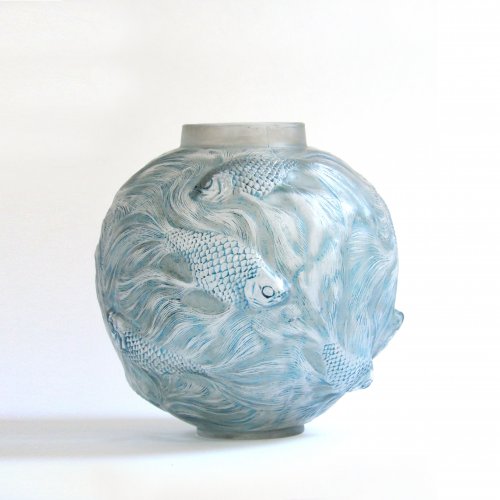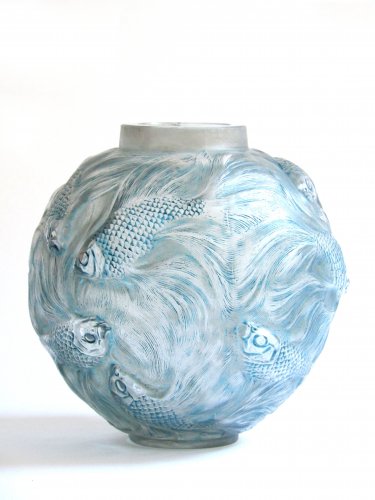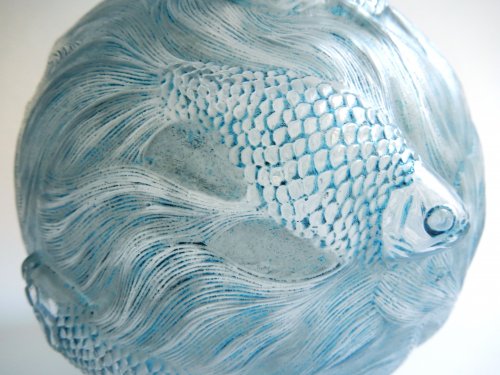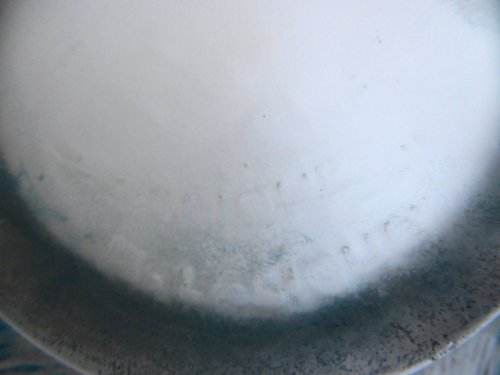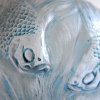René Lalique (1860-1945) Vase 'Formose'
About this piece
Beautiful vase with Koi's, called 'Formose' by René Lalique, he designed this vase in 1924 for the 1925 World Exhibition in Paris ( Exposition Internationale des Arts Décoratifs), where the term Art Deco originated.
This vase is blown into the mould and then finished by hand. The glass is patinated with a blue powder patina.
This vase was only produced for a short time as Lalique decided in the early 1930's to remove the vase , along with other vases, from the collection as a cutback due to the depression.These vases were labour-intensive to produce, still blown in the mould, instead of pressed, and the finishing was still done by hand. The vase was then only available from stock.
The vase is 18 cm high and signed twice on the bottom with a moulded signature 'R. Lalique'.
Biography:
René Lalique (1860-1945) was active as an
apprentice jeweller at age 16. After been 2 years in England as an
apprentice, he started his own business ,in 1880, as a jewellery
designer. He soon became a success, especially after he participated at
the Universal Exhibition of 1900 in Paris. Thereafter his name was
definitively established.
From 1890 he was also very interested in glass. He adapted glass in his designs. He soon expanded his work with the proper tools and equipment, and also increased his knowledge, especially in the field of colouring and moulds. In 1905 he received orders from François Coty to design various perfume bottles, he experimented with new styles and techniques. During that time he started to work with moulds and pressed glass. In 1912 he started his second career as a master glass artist. He once said that he would create something so special that's not been seen before. Which he certainly succeeded.
He then made except small glass objects such as jewellery and perfume bottles, major works as vases, lamps, tableware, clocks, car mascots, but also architectural glass applications such as door handles, wall panels etc.
After WWI, the French government offered him for not much money a factory in the Alsace, the Alsace was French again. He built a new glass factory in Wingen-sur-Moder where he produced most of his pressed glass vases. Mid 1930's he closed his factory in Paris and everything was produced in Wingen-sur-Moder, till now. After his death in 1945, his family continued the company.
He is seen as one of the largest glass artists in the world. His
work is admired worldwide in museums, there are also several museums
that are only dedicated to René Lalique, such as Lalique Museum Doesburg
in the Netherlands and of course Musée Lalique in Wingen-sur-Moder,
France, but also in Hakone (Japan) and many others.
Literature:
- Félix Marcilhac, ‘R. Lalique,
Catalogue raisonné de l’oeuvre de verre’, Les Éditions de l’Amateur,
Paris 2011, p. 425.
- Christopher Vane Percy; 'The glass of Lalique, a
collectors guide', Studio Vista, Cassell & Collier Macmillan
Publishers Ltd, London, 1977. P. 24.
- Philippe Olland; 'Dictionnaire
des Maîtres Verriers de l'Art Nouveau á l'Art Déco, Marques &
signatures'. Éditions Faton 2016. P. 192-199.
- Victor Arwas, 'Glass, Art Nouveau to Art Deco'. Academy Editions
London 1987.
Condition
Good, small polished spot on the foot.
Material:
Glass
Measurements:
Height: 18 cm
(7,09")
Period:
Design 1924
Origin:
France
Artist / atelier:
René Lalique,
